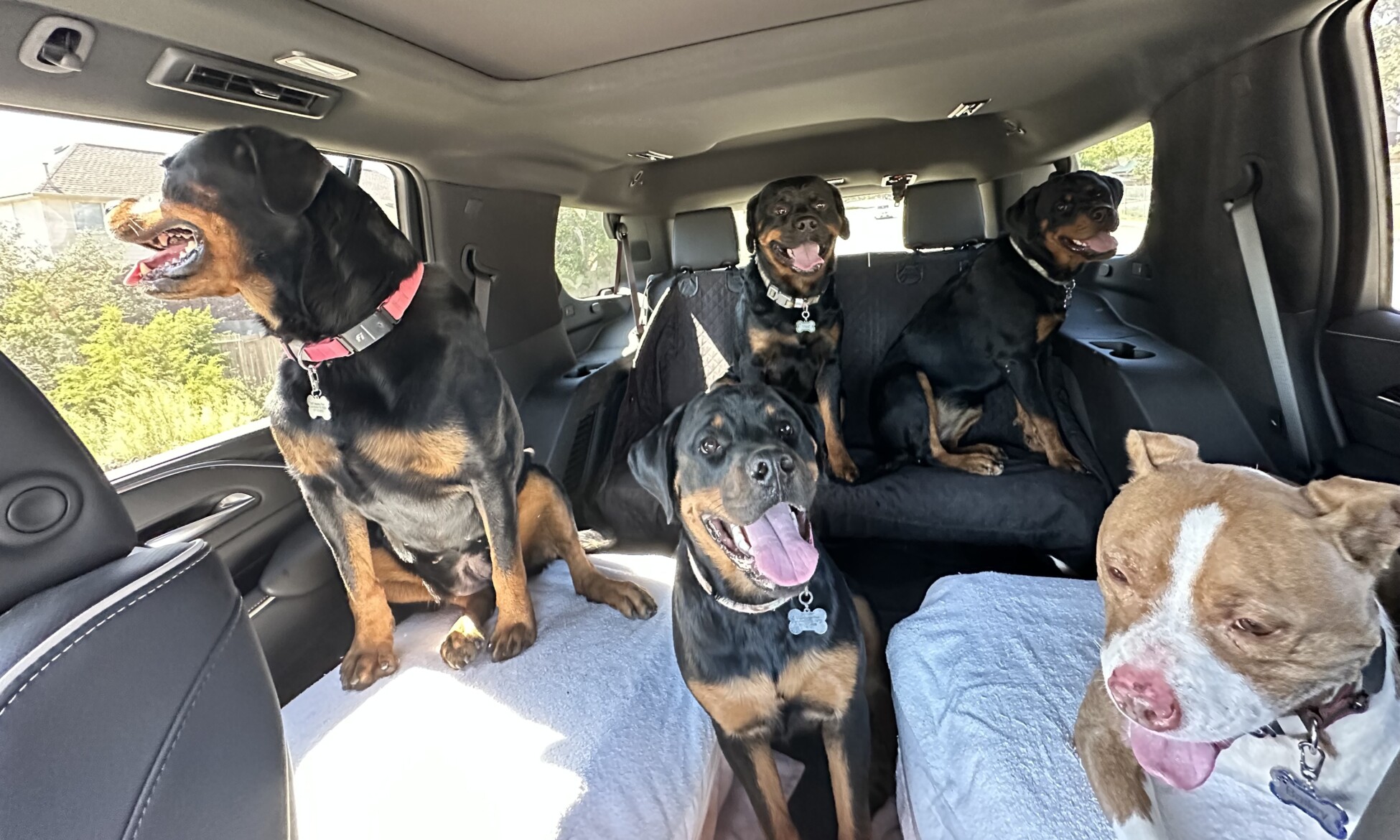
Ed
MemberForum Replies Created
-
Is she playing with you? If so that is not bad, it is affections and needs to be redirected. Can you redirect with a toy where both of you play, like a tug toy!
If the trainer told you that you are too soft it does not mean the dog is bad, but in an ideal world you should be able to interrupt a dog’s behavior with body posture or a word. That is harder to teach (the human), but the workaround is to artificially add structure, which is a regulated life for the dog where you control everything.
An ecollar is not necessary the solution. Personally if a dog does something I do not like during play I interrupt play, and that takes care of the issue. Followed by a reassurance that I still love him.
Hope it helps a bit
-
I think the recommendation is to only walk multiple dogs at once when they perfect at walking, which means at that point there would not be corrections. I used to walk one dog on each side, but then with 3 I changed to all on the left. I have not tried to walk more than 3 because it would probably get too iffy to hold that many adult dogs back.
As a side note, when you walk more than one dog, if they get into a scuffle or even a bark and lunge thing, you are very limited on what you can do — that, to me, is the biggest issue with walking more than one dog at once. Also their personalities change. You can have a perfect one dog walking and you add a second dog and now he may be all over the place. Good luck. Hope it helps a bit.
One more thing. With multiple dogs, you risk redirection as well. So it would be important to be able to stop behaviors by voice.
-
3 thoughts. (1) When I hike with dogs (have not done in maybe a year) I use very long leashes to give them more freedom, but also to negotiate obstacles like climbing up and down. (2) It is not a bad thing to realign expectations. With one dog it was a lot of fun to hike. With two it is more work. With 3 or more I do not trust them or myself to manage the situations that may arise. The net is that I seldomly hike now. I suppose I could work all of them to be able to hike like a pack, but that is a lot of work and possibly an impossible standard for me at this point. (3) a hard correction is better than endless soft corrections. I believe emotionally a dog will brush off a hard correction if it is fair and clear, but endless nagging corrections, I think, erode their confidence. Hope is helps some.
-
Here is where I’m coming from. I have worked with 2 top tier trainers in person. One for agility and the other for protection. My dogs in their hands is like a virtuoso playing a Stradivarius. Me with my dogs is like me driving a Mac truck. The dogs are the same. So I can get frustrated and angry at the dogs, but virtually everything they do well, to the degree that they do a few things well, is despite my limitations.
What would do is to reach out to Robert in the AMA and ask for a trainer recommendation in your area. It will be expensive but the trainer should be able to look at you and your dog and train you accordingly.
The neutering does not affect character. It is like a man and testosterone, a bastard is still a bastard, the difference is that instead of mowing the lawn he will be watching TV 😂
-
Another impulse control exercise is to ask the dog to sit before eating. You ask sit, they sit, you put the food down, and if they go for it you reinforce the sit or remove the food. Once they remain sat for a few seconds with the food in front of them you release them by saying break. It is a great exercise for impulse control and to reinforce the dynamics of the relationship. Depending on where your relationship with your dog is you may have to make some adjustments, but that is the idea.
-
Also note that when dogs get very excited they sometimes revert. That is where impulse control comes in. I have a 4 year old male Rottweiler that every 4-6 months gets super happy with me and nibbles on my ear or my face. I say ai and he looks at me with the I’m sorry face. I have a 2-1/2 year old female that likes to take my fingers into her mouth and gently pressure them. She does that where my other dogs would give me a quick lick or a little nose bump. To interact with the world, and by consequence with you using their mouth is natural. Impulse control mitigates that. And a combination of respect and love makes your dog take you seriously. There is an impulse control game that is called take/leave it. You put a treat in your hand, palm up, and when the dog goes for it you say “leave it” and close your hand making a fist before he can take it. Then when he desists you open the hand, still face up showing the treat and repeat. After 2-3 times you say “take it” and this time when the dog comes to get the treat you let it pick it up from your hand. There may be other impulse control games in the site. I would do those in the house when the dog is calm, as opposed to outside where there are more distractions and excitement. Let us know how it goes 🙂
-
You said she was biting your arms and sometimes face. Meaning she is either jumping really or you are coming down at her level, possibly knelling. You also said it is too intense to redirect… a common strategy to eliminate behavior is to not give the dog the opportunity to practice the behavior. I’m guessing that perhaps this is happening as you bend down or kneel. Instead of having the dog start the interaction, try taking the initiative and use a tug toy to play with her (you standing and pulling on the toy). You can also teach her to fetch. Have at least 2 balls that way you do not have to take the ball from her. I seldomly take the toys from my dogs. This is to teach them that the value of play is not in the toy but in me. Maybe you will need to have a dozen balls because she will not give them back or allow you to pick up. It does not really matter now. You are not competing with him/her for the ball, you are adding to the experience.
Perhaps you can give more details or make a video of the interaction. I’m having trouble visualizing what is going on.
-
In general, the trainer fixes you not the dog. That is, the trainer trains you on how to manage the dog.
-
A fundamental aspect of the relationship with a dog is respect. When the trainer said it was your fault what did he suggest you do or change?
Fear is a trigger, so that part of the mindset will need to change.
From this conversation it seems that you will need to add structure.
Did you ask Robert for advice in the AMA (member question form) or when he does the live member questions?
Maybe you can have a friend make a short video of these interactions where the problem is surfacing.

